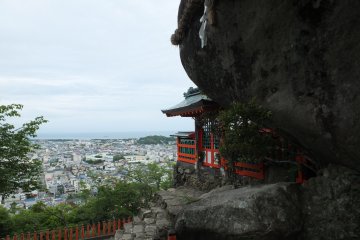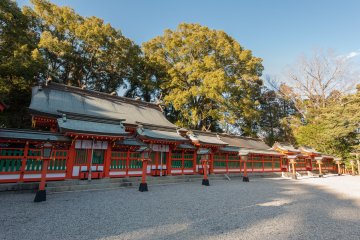
Kamikura Shrine (神倉神社, Kamikura Jinja) is related to the Hayatama Taisha Shrine and can be found on top of a hill of 538 stone steps, some as steep as 45 degrees. Facing east makes the shrine a good place for watching the sunrise. Every year on February 6 the Oto matsuri, a fire festival, is held where they run from the top to the bottom of the hill in the dark.

Kumano Hayatama Taisha is a Shinto shrine in Shingu, Wakayama. It is located at the mouth of the Kumano-gawa River, where the water flows from the heights of the Kii Mountains into the vastness of the Pacific Ocean. The Kumano Hayatama Taisha Shrine was included in the UNESCO list of "Holy Places and Pilgrimage Routes in the Kii Mountains" as part of the Kumano Sanzan. Together with the other two shrines, Hongu Taisha and Nachi Taisha, Hayatama Taisha occupies an important place in Japanese mythology. Religious artifacts that date back to the 3rd century testify that the area has been a place of worship for much longer. In fact, a Shinto creation myth claims that three Kami (Shinto deities) descended to earth on a rock not far from the shrine.

For over 1,000 years, Japanese people from all walks of life, including retired emperors and aristocrats, have made the arduous pilgrimage of Wakayama. The Kumano Kodo is a network of ancient pilgrimage routes that traverse the Kii Peninsula in southern Wakayama Prefecture. These sacred paths have become Created to serve as pilgrimage routes to enter the sacred Kumano Sanzan area, which includes the three great shrines of Kumano Hongū Taisha, Kumano Nachi Taisha and Kumano Hayatama Taisha. In July 2004, the Kumano Kodo Pilgrimage Routes were established as part of the "Sacred Sites and Pilgrimage Routes in the Kii Mountain Range" added to the list of UNESCO World Heritage Sites. There are 4 main routes in total: The Nakahechi Route is the most popular route. From the 10th century onwards, the Nakahechi route was used extensively by the imperial family on pilgrimages from Kyoto. The Kohechi route connects the Buddhist temple complex of Koyasan and Kumano-Sanzan. Hikers should be well prepared if they want to take this route. The Ohechi Route offers picturesque views over the Pacific, while the Iseji Route features a variety of mountain passes, bamboo forests, terraced rice fields and beaches.
